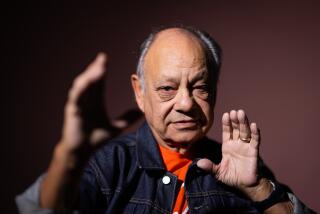‘El Dorado’ Exhibit Celebrates Golden State’s Golden Past : Museum Displays Major Collection of Historical Art
Legend has it that King El Dorado floated on a golden barge on a golden lake in a kingdom where gold abounded. Thus, after gold was discovered in California in 1848, it was little wonder that the state eventually earned the nickname “El Dorado.”
“El Dorado: Paintings of the Golden State from the California Historical Society,” a new exhibit at the Gene Autry Western Heritage Museum, pays tribute to California’s rich history.
The featured works of art do more than simply depict the miners who dreamed of finding the precious yellow metal. Instead, the paintings create a tapestry of California’s rich history, weaving visions of 19th-Century landscapes, seascapes, settlers, vaqueros and more into an aesthetic--and educational--experience.
“I think Americans have a hunger for a sense of connection to place and time,” said Nathan Sumner, executive director of the California Historical Society, headquartered in San Francisco. “Seeing the paintings gives you a set of images that provides that connection. There seems to be an empty place in all of us, and a sense of history can fill that.”
Ninety-seven oil paintings, watercolors and pencil sketches by 47 artists make up the exhibit. The earliest painting dates from 1795, while most are from 1849-1900. The works are on loan from the permanent collection of the California Historical Society, a 118-year-old organization dedicated to public history programs, education and historic preservation.
There has never been such an extensive collection of California historical paintings assembled for a public exhibition, according to James Nottage, curator of the Autry museum, which opened in November.
A work by Albert Bierstadt and two by William Hahn are probably the most recognizable in the show, Nottage said. German by birth, both artists studied in Dusseldorf, which during the mid-1800s was one of the world’s leading academic centers for fine artists.
It was nature’s grandeur that served as a vital inspiration for the two men. For Bierstadt, scenes of mountains became something of a trademark. “On the Merced River,” one of his paintings in the exhibit, is an example of his accuracy and skill in portraying colossal landscapes.
Yosemite Valley with its geological drama was a recurring subject in both artists’ works. Yosemite was declared a natural preserve by President Abraham Lincoln in 1864, and within a few years, eager visitors were going over the terrain to enjoy the panoramic views.
In 1874, Hahn painted “Yosemite Valley From Glacier Point,” another work included in the “El Dorado” exhibit. The cluster of tourists gazing over the valley from the 4,000-foot-high vantage point is an indication of the site’s popularity--and also testimony to a changing California. The painting captures a pastoral California on the wane.
Although Nottage said the artists in the show apparently wanted to document the wilderness, that was not their primary objective; a simple expression of beauty was. Still, the works provide insight into another era.
For British-born James Walker, it was the old Hispanic culture that created intrigue and found its way onto his canvases. During the American Civil War, Walker achieved fame as a military painter, but had set up a studio in San Francisco by the early 1870s.
Walker’s subjects were the ostentatious vaqueros who roped and branded cattle while dressed in their colorful garb. Walker’s brush helped make these ethnic cowboys unforgettable in such paintings as “Cattle Drive 1” and “Cattle Drive 2,” both on exhibit at the museum.
Mexican-born Fortunato Arriola helped make the California coastlines of the day memorable, just as J. Lamson chronicled daily activities in the mining camps, Frederick Butman recorded the lives of Chinese immigrants in a fishing village and William Jewett, a renowned New York portrait painter, became a portraitist for the nouveau riche--namely the new gold tycoons.
“Seeing all these pictures together is like being transported back into the past,” Nottage said. “These artists have created a record to allow California to look at itself. It’s a self-portrait.
“They’re allowing us to see California the way it was a century ago,” he said. “When we think of Western art, we think in terms of Remington and Russell. But this exhibit proves there’s so much more.”
“El Dorado: Paintings of the Golden State from the California Historical Society” is on exhibit through Nov. 19 at the Gene Autry Western Heritage Museum, 4700 Zoo Drive, Los Angeles. For information, call (213) 667-2000.
More to Read
Sign up for Essential California
The most important California stories and recommendations in your inbox every morning.
You may occasionally receive promotional content from the Los Angeles Times.










